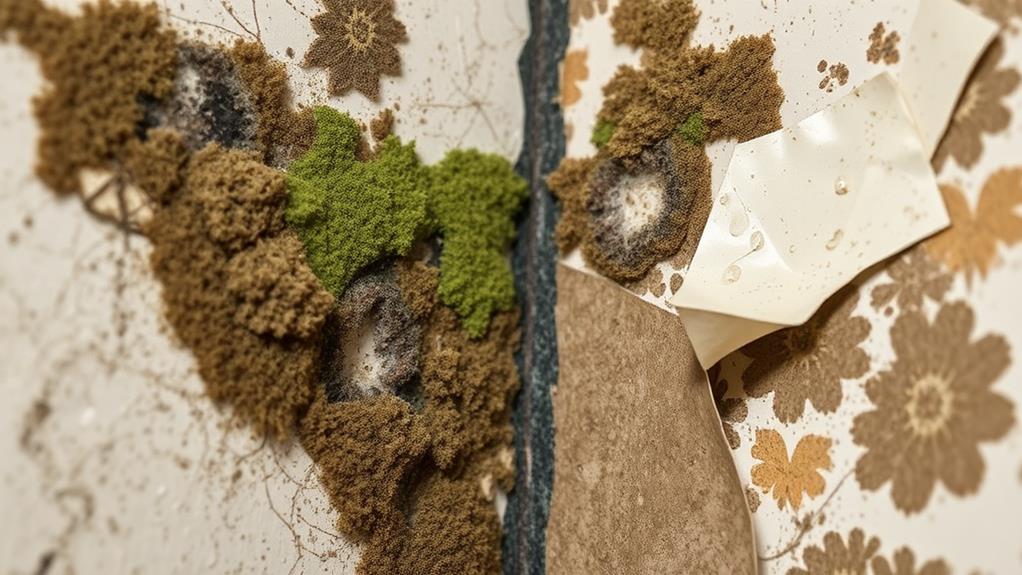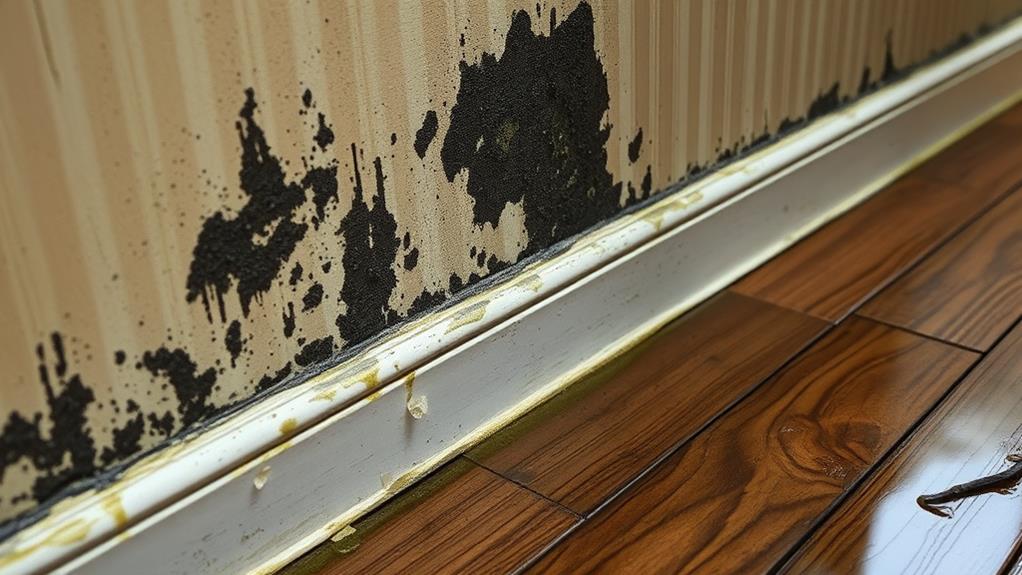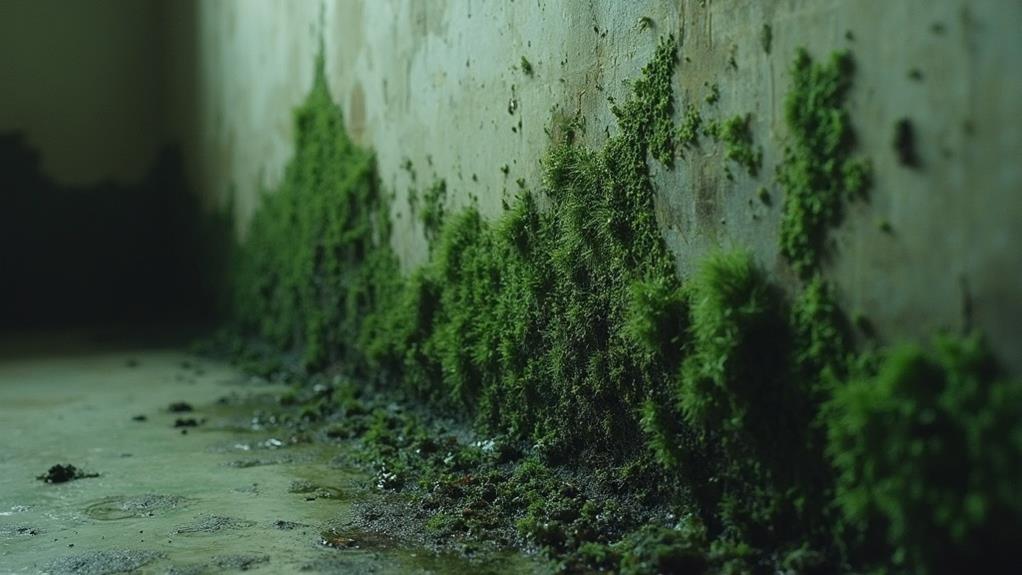Standing water in your home can rapidly lead to mold and mildew growth within 24-48 hours. These fungi thrive in moist environments and can cause serious health issues, particularly for those with respiratory conditions. Common household materials like drywall and carpets provide ideal food sources for mold. Swift action is crucial: remove water, dry affected areas, and clean surfaces with disinfectant. Proper ventilation and dehumidification are essential to prevent future growth. For extensive damage or visible mold, professional remediation may be necessary. Understanding the sources of water damage and implementing preventive measures can safeguard your home and health from fungal infestations.
Understanding Mold and Mildew Growth

Following a water intrusion event, understanding the dynamics of mold and mildew growth is crucial for homeowners. Mold and mildew are fungi that thrive in moist environments, rapidly colonizing damp surfaces within 24 to 48 hours of water exposure. These microorganisms reproduce by releasing spores, which can spread through the air and settle on new surfaces.
Mold requires three key elements to flourish: moisture, organic material, and a suitable temperature range (typically between 60°F and 80°F). Common household materials like drywall, wood, and carpet provide ample food sources for mold growth. Mildew, a specific type of mold, often appears as a powdery or downy growth on surfaces.
The presence of standing water or high humidity levels creates an ideal breeding ground for these fungi. As they grow, mold and mildew break down organic materials, causing structural damage and potential health hazards. Individuals may experience allergic reactions, respiratory issues, or other health problems when exposed to mold spores. Prompt action to address water damage and control moisture levels is essential to prevent extensive mold growth and mitigate associated risks.
Health Risks of Fungal Infestations
Amid the aftermath of water damage, fungal infestations pose significant health risks to occupants of affected homes. Exposure to mold and mildew can trigger a range of health issues, from mild allergic reactions to severe respiratory problems. Common symptoms include coughing, wheezing, nasal congestion, eye irritation, and skin rashes.
Individuals with pre-existing respiratory conditions, such as asthma or chronic obstructive pulmonary disease (COPD), are particularly vulnerable to the effects of mold exposure. In some cases, prolonged exposure can lead to the development of hypersensitivity pneumonitis, a potentially serious lung inflammation.
Certain mold species produce mycotoxins, which can cause neurological symptoms, including headaches, memory loss, and mood changes. Immunocompromised individuals face an increased risk of opportunistic fungal infections, which can be life-threatening.
Children, elderly adults, and pregnant women are more susceptible to mold-related health issues. In infants, exposure to mold has been linked to the development of asthma and other respiratory conditions.
To mitigate these health risks, prompt remediation of water damage and mold growth is essential. Professional assessment and removal of fungal infestations can help ensure a safe and healthy living environment for all occupants.
Identifying Water Damage Sources

To effectively combat mold and mildew growth after water damage, it's crucial to pinpoint the sources of moisture intrusion. Common culprits include roof leaks, plumbing issues, and foundation cracks.
Inspect your roof for missing shingles, damaged flashing, or deteriorated seals around vents and chimneys. Check for water stains on ceilings and walls, which may indicate hidden leaks within the structure.
Examine plumbing fixtures, pipes, and connections for signs of leakage or condensation. Pay special attention to areas under sinks, around toilets, and behind appliances like washing machines and dishwashers. Basement moisture can often be traced to foundation issues or poor drainage around the home's perimeter. Look for cracks in the foundation walls and ensure that gutters and downspouts are directing water away from the house.
High indoor humidity levels can also contribute to mold growth. Use a hygrometer to measure relative humidity and address any areas exceeding 60%. Identify and fix sources of excess moisture, such as poorly ventilated bathrooms or kitchens, to prevent future mold problems. By systematically identifying and addressing water damage sources, you can effectively mitigate mold and mildew growth in your home.
Prevention and Immediate Action
Three key steps are essential for preventing mold and mildew growth after water damage: rapid water removal, thorough drying, and proper cleaning. Begin by extracting standing water using pumps, wet vacuums, or professional water removal services. Time is critical; act within 24-48 hours to minimize mold growth potential.
Next, focus on thorough drying. Use dehumidifiers, fans, and open windows to increase air circulation. Remove wet carpets, furniture, and other porous materials. For extensive damage, consider hiring professional drying services with industrial-grade equipment.
Proper cleaning is crucial to eliminate remaining moisture and potential contaminants. Use a solution of water and disinfectant to clean all affected surfaces. Pay special attention to hidden areas like wall cavities and under flooring.
For immediate action, prioritize safety by turning off electricity in affected areas and wearing protective gear. Document the damage for insurance purposes. Remove valuable items and relocate them to dry areas. If mold is already visible or the damage is extensive, consult a professional mold remediation service. They can assess the situation, perform necessary treatments, and ensure your home is safe and mold-free.
Professional Remediation Techniques

Professional mold remediation involves several advanced techniques that go beyond basic cleaning and drying. Certified mold remediation specialists employ a multi-step process to ensure thorough removal and prevention of future growth.
The first step typically involves containment, where affected areas are sealed off to prevent spore spread. High-efficiency particulate air (HEPA) filtration systems are then used to purify the air. Next, specialized antimicrobial treatments are applied to kill existing mold and inhibit future growth.
For severe cases, professionals may utilize dry ice blasting or soda blasting techniques. These methods effectively remove mold from porous surfaces without causing additional damage. In some instances, thermal fogging is employed to neutralize odors and eliminate airborne spores in hard-to-reach areas.
After removal, professionals often apply encapsulants to seal treated surfaces, providing an extra layer of protection against moisture and mold regrowth. Throughout the process, moisture levels are constantly monitored and controlled using industrial dehumidifiers and air movers.
Frequently Asked Questions
Can Mold Grow in Air Ducts and Spread Throughout the House?
Yes, mold can indeed grow in air ducts and spread throughout the house. This occurs when moisture accumulates in the ductwork, creating an ideal environment for mold growth. Regular HVAC system maintenance and inspection are crucial to prevent this issue.
Are Certain Types of Mold More Dangerous Than Others?
In the vast jungle of mold species, some are indeed more perilous than others. Certain types, like Stachybotrys chartarum (black mold) and Aspergillus, can pose significant health risks, potentially causing respiratory issues and allergic reactions in susceptible individuals.
How Long Does It Take for Mold to Start Growing After Water Damage?
Mold can begin growing within 24 to 48 hours after water damage occurs. The speed of growth depends on factors such as temperature, humidity, and the type of surface affected. Swift action is crucial to prevent mold proliferation.
Can Mold Growth Affect the Structural Integrity of My Home?
Like a silent invader, mold growth can indeed compromise your home's structural integrity. It feeds on organic materials, weakening wood, drywall, and other building components over time. This degradation can lead to significant structural issues if left unchecked.
Are Household Bleach and Vinegar Effective for Killing Mold and Mildew?
Household bleach and vinegar can be effective for killing mold and mildew on non-porous surfaces. However, they may not penetrate porous materials completely. For extensive mold issues, professional remediation is recommended to ensure thorough eradication and prevent recurrence.
Conclusion
In conclusion, addressing standing water promptly is paramount to prevent mold and mildew proliferation. Swift action, including thorough drying and professional remediation, can mitigate health risks and structural damage. Homeowners must remain vigilant, identifying potential water sources and implementing preventative measures. As Benjamin Franklin wisely stated, "An ounce of prevention is worth a pound of cure." By understanding fungal growth patterns and maintaining a dry environment, individuals can safeguard their homes and health from the insidious effects of mold and mildew infestations.

